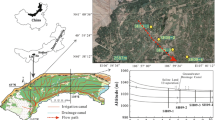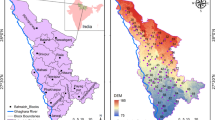Abstract
Organic arsenical herbicides, which include monosodium methylarsonate (MSMA), have been applied to golf courses and lawns throughout Florida, USA, since the 1950s. These products convert rapidly to inorganic forms of arsenic (As) in soils and are mobilized readily. Leachates have been known to contaminate groundwater and surface waters, although past studies have not examined whether use of these products has led to significant As accumulation in lake sediments. We used paleolimnological methods to document the depositional history and inventories of total As in sediments and porewaters of Little Lake Jackson in Florida, which is adjacent to three golf courses. Six sediment cores, four of which were 210Pb dated, showed porewater total As concentrations as high as 435 μg l−1, and dry-sediment total As concentrations as high as 148 mg kg−1. Approximately 537 kg of total As is present in >19,000 metric tons of sediment (dry mass), and an additional 18 kg of As is dissolved in 10.8 × 104 m3 of porewaters. Total As content in surface sediments (mean = 47.3 mg kg−1) exceeds the consensus-based sedimentary concentration for probable toxicity effects in freshwater benthic fauna. Surface and subsurface waters flow to the lake from topographically higher areas to the west, where golf courses and residential areas are located. Total As concentrations were elevated highly in monitoring wells and in a stream that flows between the golf courses and lake, but As was below detection limits in wells that were located at the distal perimeter of the golf courses. Subsurface and surface waters exit the lake towards topographically lower areas to the east. Nearly all As in sediments remains bound in the solid phase, indicating that As sedimentary profiles largely reflect depositional history. Sedimentary As concentrations are correlated strongly with aluminum and iron, which suggests that As was scavenged from lake waters during the past. Sedimentary As concentrations increased until the 1980s, then declined somewhat to the present time. Dissolved As was scavenged efficiently from the water column when hypolimnetic waters were oxygenated persistently, but after eutrophication led to a seasonally anoxic hypolimnion in the 1980s, apparently less As was co-precipitated, and more was lost to hydrological outflow. Arsenic accumulation in sediments might be common in areas where As derived from organic arsenical herbicide applications is directed by shallow water tables towards adjacent lakes.





Similar content being viewed by others
References
Ahmann D, Krumholz LR, Hemond HF, Lovley DR, Morel FM (1997) Microbial mobilization of arsenic from sediments of the Aberjona watershed. Environ Sci Technol 31:2923–2930
Alam MGM, Tokunaga S, Maekawa T (2001) Extraction of arsenic in a synthetic arsenic-contaminated soil using phosphate. Chemosphere 43:1035–1041
Anawar HM, Akai J, Sakugawa J (2004) Mobilization of arsenic from subsurface sediments by effect of bicarbonate ions in groundwater. Chemosphere 54:753–762
Appleby PG, Oldfield F (1983) The assessment of 210Pb data from sites with varying sediment accumulation rates. Hydrobiologia 103:29–35
Arnold DG, Richardson DC (1995) Highlands ridge report. Southwest Florida Water Management District Engineering Section unpublished report. Brooksville, FL, 380 pp
Bauer M, Blodau C (2006) Mobilization of arsenic by dissolved organic matter from iron oxides, soils and sediments. Sci Total Environ 354:179–190
Belzile N, Tessier A (1990) Interactions between arsenic and iron oxyhydroxides in lacustrine sediments. Geochim Cosmochim Acta 54(1):103–109
Boyle J (2004) A comparison of two methods for estimating the organic matter content of sediments. J Paleolimnol 31:125–127
Cai Y, Cabrera JC, Georgiadis M, Jayachandran K (2002) Assessment of arsenic mobility in the soils of some golf courses in South Florida. Sci Total Environ 291:123–134
Carter LJ, Lewis D, Crockett L, Vega J (1989) Soil survey of Highlands County, Florida. U.S. Dept. of Agriculture, Soil Conservation Service
Chen CY, Sternberger RS, Klaue B, Blum JD, Pickhardt PC, Folt CL (2000) Accumulation of heavy metals in food web components across a gradient of lakes. Limnol Oceanogr 45:1525–1536
Chen ZR, Cai Y, Solo-Gabriele H, Snyder GH, Cisar JL (2006) Interactions of arsenic and the dissolved substances derived from turf soils. Environ Sci Technol 26(40):4659–4665
Crecelius EA (1975) The geochemical cycle of arsenic in Lake Washington and its relation to other elements. Limnol Oceanogr 20:441–451
Davenport JR, Peryea FJ (1991) Phosphate fertilizers influence leaching of lead and arsenic in a soil contaminated with lead arsenate. Water Air Soil Pollut 57–58:101–110
DERM (Department of Environmental Resources Management) (2002) Environmental quality monitoring at five municipal golf courses in Miami-Dade County. Final report, 159 pp
De Vitre RR, Belzile N, Tessier A (1991) Speciation and adsorption of arsenic on diagenetic iron oxyhydroxides. Limnol Oceanogr 36:1480–1485
Durant JL, Ivushkina T, MacLaughlin K, Lukacs H, Gawel J, Senn D, Hemond HF (2004) Elevated levels of arsenic in the sediments of an urban pond: sources, distribution and water quality impacts. Water Res 38:2989–3000
Feng M, Schrlau JE, Snyder R, Snyder GH, Chen M, Cisar JL, Cai Y (2005) Arsenic transport and transformation associated with MSMA application on a golf course green. J Agric Food Chem 53:3556–3562
Fisher MM, Brenner M, Reddy KR (1992) A simple, inexpensive piston corer for collecting undisturbed sediment/water interface profiles. J Paleolimol 7:157–161
Florida DEP (Florida Department of Environmental Protection) (1994) Lake bioassessments for the determination of non-point source impairment in Florida. Florida Department of Environmental Protection, Biological Section, Tallahasse, FL, 74 pp
Florida DEP (Florida Department of Environmental Protection) (2002) Environmental risks from the use of organic arsenical herbicides at South Florida golf courses. Florida DEP Website address http://fdep.ifas.ufl.edu/MSMA%20Dec%2027%202002.pdf. Accessed December 2007
Kolasa KV (1997) Little Lake Jackson water quality assessment. Unpublished report of Southwest Florida Water Management District, Brooksville, FL, USA, 33 pp
Kolasa KV (1999) Little Lake Jackson stormwater runoff analyses. In: Proceedings of the sixth biennial stormwater research and watershed management conference. Southwest Florida Water Management District, Brooksville, FL, USA, 14–17 September 1999, pp 41–59
Kopáček J, Hejzlar J, Borovec J, Porcal P, Kotorová I (2000) Phosphorus inactivaton by aluminum in the water column and sediments: lowering of in-lake phosphorus availability in an acidified watershed-lake ecosystem. Limnol Oceanogr 45:212–225
Ma LQ, Harris WG, Sartain J (2000) Environmental impacts of lead pellets at shooting ranges and arsenical herbicides on golf courses in Florida. Florida Center for Solid and Hazardous Waste Management Report #00-03, Gainesville, FL, 50 pp
Ma LQ, Cao RX, Hardison D, Chen M, Harris WG, Sartain J (2002) Environmental impacts of lead pellets at shooting ranges and arsenical herbicides on golf courses in Florida. Florida Center for Solid and Hazardous Waste Management Report #02-01, Gainesville, FL, 82 pp
MacDonald DD, Ingersoll CG, Berger TA (2000) Development and evaluation of consensus-based sediment quality guidelines for freshwater ecosystems. Arch Environ Contam Toxicol 39:20–31
Murphy EA, Aucott M (1998) An assessment of the amounts of arsenical pesticides used historically in a geographical area. Sci Total Environ 218:89–101
Nikolaidis NP, Dobbs GM, Chen J, Lackovic JA (2004) Arsenic mobility in contaminated lake sediments. Environ Pollut 129:479–487
Peterson ML, Carpenter R (1986) Arsenic distributions in porewaters and sediments of Puget Sound, Lake Washington, the Washington coast and Saanich Inlet, BC. Geochim Cosmochim Acta 50(3):353–369
Rutter RP (1995) A bioassay of nine lakes in Highlands County, Florida with emphasis on the macroinvertebrate fauna. Florida Department of Environmental Protection Report, Punta Gorda, FL, 118 pp
Schaller T, Moor HC, Wehrli B (1997) Sedimentary profiles of Fe, Mn, V, Cr, As and Mo as indicators of benthic redox conditions in Baldeggersee. Aquat Sci 59:345–361
Schelske CL, Peplow A, Brenner M, Spencer CN (1994) Low-background gamma counting: applications for 210Pb dating of sediments. J Paleolimol 10:115–128
Sohrin Y, Matsui M, Kawashima M, Hojo M, Hasegawa H (1997) Arsenic biogeochemistry affected by eutrophication in Lake Biwa, Japan. Environ Sci Technol 31:2712–2720
Solo-Gabriele H, Sakura-Lemessy DM, Townsend T, Dubey B, Jambeck J (2003) Quantities of arsenic within the state of Florida. Florida Center for Solid and Hazardous Waste Management Report #03-06, Gainesville, FL, 153 pp
U.S. EPA (Environmental Protection Agency) (1994a) Method 7062 antimony and arsenic (Atomic absorption, borohydride reduction). U.S. Environmental Protection Agency
U.S. EPA (Environmental Protection Agency) (1994b) Method 200.7 (Revision 4.4): determination of metals and trace elements in water and wastes by inductively coupled plasma-atomic emissions spectrometry. U.S. Environmental Protection Agency
U.S. EPA (Environmental Protection Agency) (2002) The implementation guidance for the arsenic rule: drinking water regulations for arsenic and clarification to compliance and new source contaminance monitoring. U.S. Environmental Protection Agency Implementation Guide 816-K-02-018, 83 pp
U.S. EPA (Environmental Protection Agency) (2006) Organic arsenical herbicides (MSMA, DSMA, CAMA, and Cacodylic Acid), reregistration eligibility decision; notice of availability. U.S. Environmental Protection Agency, Federal Register Environmental Documents. URL: http://www.epa.gov/fedrgstr/EPA-PEST/2006/August/Day-09/p12905.htm. Accessed 29 March 2007
Whitmore TJ, Brenner M, Kolasa KV, Kenny WF, Riedinger-Whitmore MA, Curtis JH (2006) Inadvertent alkalization of a Florida lake caused by increased nutrient and solute loading to its watershed. J Paleolimnol 36:353–370
Acknowledgements
We thank Keith Dominey at Waters Analytical Laboratory for technical support. Terrence Quinn provided use of ICP-OES equipment. Xuefeng (Bob) Wang, Clell Ford, and Charlotte Clayton helped with collection of sediment cores, and Monique Baughman helped with collection of stream and well samples. Todd Robbins assisted with sediment digestion and with 210Pb dating. James Sickman, John Smol, and Mark Brenner provided helpful review of the manuscript. Partial support for this study was provided by the University of South Florida-St. Petersburg’s Environmental Science, Policy, and Geography Program.
Author information
Authors and Affiliations
Corresponding author
Rights and permissions
About this article
Cite this article
Whitmore, T.J., Riedinger-Whitmore, M.A., Smoak, J.M. et al. Arsenic contamination of lake sediments in Florida: evidence of herbicide mobility from watershed soils. J Paleolimnol 40, 869–884 (2008). https://doi.org/10.1007/s10933-008-9204-8
Received:
Accepted:
Published:
Issue Date:
DOI: https://doi.org/10.1007/s10933-008-9204-8




